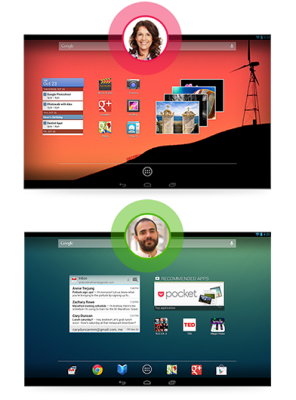One of the coolest (and most useful) features of Google’s Android Jelly Been 4.2 update is multiple user account switching, offering up the option to have several users share access to a device, while keeping their settings and content walled off from each other. It’s something we’ve been used to on PCs forever, so it’s bound to be welcomed by Android users. However, we’ve learned that the new feature will likely only apply to tablets, certainly as far as Google’s Nexus range is concerned. Phones need not apply. The reason — and this is purely an educated guess on my part — could well be that back in the day Nokia already patented the idea (via its involvement with Symbian).
Here we go again.
Update: It now appears that, contrary to my original understanding and source, the patent may have never been granted in the U.S. In contrast, it was certainly granted in the UK but may have subsequently lapsed.
The patent ‘Multi-user mobile telephone’, whose inventor is Tim Ocock, an ex-Symbian employee, is described as follows:
A mobile telephone is designed to be used by several different end-users at different times. A first end-user can alter the mobile telephone so that it operates in a manner specific to that first end-user and a subsequent end-user can alter the mobile telephone so that it operates in a manner specific to that subsequent end-user; each end-user has only to respond to prompts displayed on a screen in order to alter the mobile telephone so that it operates in a manner specific to that end-user.
In contrast, here’s how Google’s marketing material describes the new tablet-only Android feature (my emphasis):
With support for multiple users, you can give each person their own space. Everyone can have their own homescreen, background, widgets, apps and games – even individual high scores and levels! And since Android is built with multitasking at its core, it’s a snap to switch between users – no need to log in and out. Available only on tablets.
As I understand it, the use-case that Nokia had in mind was emerging markets where the prohibitive cost of a mobile phone might mean that family members shared the device. But clearly, the patent is more widespread than that. And whilst it might be a more relevant and useful feature on a post-PC tablet device, the fact that Nokia appears to hold a patent for multiple user switching on a phone, might well explain why Google is limiting the feature to tablets only and not phones.
More from that Symbian/Nokia patent:
The present invention therefore moves away from the established assumption that a mobile telephone is personal to a single end-user and instead readily allows the mobile telephone to be used by several end-users through appropriate on-screen prompts. Such a device may be especially relevant to communities where few individuals can afford the cost of their own personal telephone. More generally, it is useful for any entity to whom there are benefits from being able to easily share mobile telephones across multiple end-users (e.g. large corporation may have a pool of such mobile telephones; any employee can then simply pick up one of these telephones and be able to use it like a personal device).
